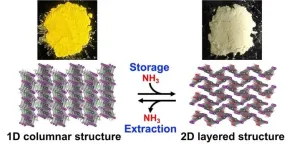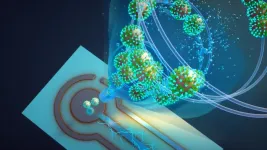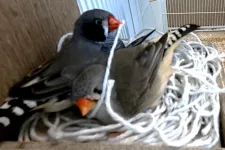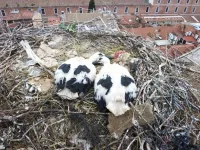A safe, easy, and affordable way to store and retrieve hydrogen
2023-07-10
(Press-News.org)
Researchers at the RIKEN Center for Emergent Matter Science (CEMS) in Japan have discovered a compound that uses a chemical reaction to store ammonia, potentially offering a safer and easier way to store this important chemical. This discovery, published in the Journal of the American Chemical Society on July 10, makes it possible not only to safely and conveniently store ammonia, but also the important hydrogen is carries. This finding should help lead the way to a decarbonized society with a practical hydrogen economy.
For society to make the switch from carbon-based to hydrogen-based energy, we need a safe way to store and transport hydrogen, which by itself is highly combustible. One way to do this is to store it as part of another molecule and extract it as needed. Ammonia, chemically written as NH3, makes a good hydrogen carrier because three hydrogen atoms are packed into each molecule, with almost 20% of ammonia being hydrogen by weight.
The problem, however, is that ammonia is a highly corrosive gas, making it difficult to store and use. Currently, ammonia is generally stored by liquefying it at temperatures well below freezing in pressure-resistant containers. Porous compounds can also store ammonia at room temperature and pressure, but storage capacity is low, and the ammonia cannot always be retrieved easily. The new study reports the discovery of a perovskite, a material with a distinctive repetitive crystal structure, which can easily store ammonia and also allows easy and complete retrieval at relatively low temperatures.
The research team led by Masuki Kawamoto at RIKEN CEMS focused on the perovskite ethylammonium lead iodide (EAPbI3), chemically written as CH3CH2NH3PbI3. They found that its one-dimensional columnar structure undergoes a chemical reaction with ammonia at room temperature and pressure, and dynamically transforms into a two-dimensional layered structure called lead iodide hydroxide, or Pb(OH)I. As a result of this process, ammonia is stored within the layered structure through chemical conversion. Thus, EAPbI3 can safely store corrosive ammonia gas as a nitrogen compound in a process that is much cheaper than liquification at -33°C (-27.4°F) in pressurized containers. Even more importantly, the process to retrieve the stored ammonia is just as simple.
“To our surprise, ammonia stored in ethylammonium lead iodide could be easily extracted by heating it gently,” says Kawamoto. The stored nitrogen compound undergoes a reverse reaction at 50°C (122°F) under vacuum and returns to ammonia. This temperature is much lower than the 150°C (302°F) or more that is needed to extract ammonia from porous compounds, making EAPbI3 an excellent medium for handling corrosive gases in a simple and cost-effective process. Additionally, after returning to the one-dimensional columnar structure, the perovskite can be reused, allowing ammonia to be repeatedly stored and extracted. An added bonus was that the normally yellow compound became white after the reaction. According to Kawamoto, “the compound’s ability to change color when storing ammonia means that color-based ammonia sensors can be developed to determine the amount of ammonia stored.”
The new storage method has several uses. In the short-term, the researchers have developed a safe method for storing ammonia, which already has multiple uses in society, from fertilizer to pharmaceuticals to textiles. “In the long-term,” says to co-author Yoshihiro Ito of RIKEN CEMS, “we hope that this simple and efficient method can be a part of the solution for achieving a decarbonized society through the use of ammonia as carbon-free hydrogen carrier.”
This research will help achieve the 2016 Sustainable Development Goals (SDGs) set forth by the United Nations, especially Goal 7: Affordable and clean energy and Goal 13: Climate action.
END
[Attachments] See images for this press release:

ELSE PRESS RELEASES FROM THIS DATE:
2023-07-10
A lollipop might be a sweet reward for a kid who’s endured a trip to the doctor's office, but now, this candy could make diagnostic testing during a visit less invasive and more enjoyable. Researchers publishing in ACS’ Analytical Chemistry have shown, for the first time, that a lollipop-based saliva collection system can capture bacteria from adults and remain shelf-stable for up to a year. Study participants also preferred the candies over conventional collection systems.
Throat swabs are commonly used to collect samples for the diagnosis of a wide variety of illnesses, including strep throat. A less-gag-inducing method is saliva sampling, in which technicians ...
2023-07-10
Now that the emergency phase of the COVID-19 pandemic has ended, scientists are looking at ways to surveil indoor environments in real time for viruses. By combining recent advances in aerosol sampling technology and an ultrasensitive biosensing technique, researchers at Washington University in St. Louis have created a real-time monitor that can detect any of the SARS-CoV-2 virus variants in a room in about 5 minutes.
The inexpensive, proof-of-concept device could be used in hospitals and health care facilities, schools and ...
2023-07-10
Statement Highlights:
The American Heart Association supports a value-based care and payment (VBP) system that is person-centered, equitable, coordinated and seeks to improve equity, patient and provider experience, and individual and population health while controlling costs.
Defining and improving clinician understanding of value-based payment program design and best practices promotes informed decisions for participating and successfully engaging in these models.
Embargoed until 4:00 a.m. CT/5:00 a.m. ET, Monday, July 10, 2023
DALLAS, July 10, 2023 — The American Heart Association, a global force for longer, healthier lives for all, ...
2023-07-10
Indigenous Peoples in Canada have higher illness rates and lower life expectancies than non-Indigenous Canadians. A new study reveals that Indigenous men in the country who have prostate cancer are being diagnosed with more advanced and more aggressive tumors than their non-Indigenous counterparts. The findings are published by Wiley online in CANCER, a peer-reviewed journal of the American Cancer Society.
To identify disparities in prostate cancer screening, diagnoses, management, and outcomes between Indigenous and non-Indigenous men in Canada, a team led by Adam Kinnaird, MD, PhD, of the University of Alberta, ...
2023-07-10
Ülo Mander, Professor of Physical Geography and Landscape Ecology at the University of Tartu, received the Advanced Grant from the European Research Council to study the cycle of nitrous oxide (N2O), commonly known as the laughing gas, in fens and peatlands, its links to global climate change, and possible land-use practices that could help curb the production of this greenhouse gas in the future.
Laughing gas is one of the most dangerous greenhouse gases produced by microbial life in the soils of agricultural areas and drained ...
2023-07-10
Financial payments made by land developers to offset their impacts on threatened species may fall short, according to University of Queensland-led research.
Professor Jonathan Rhodes from the School of the Environment focused on koala populations in the fast-developing South East Queensland region and a government scheme which allows developers to make financial payments to compensate for environmental consequences.
“Just like when you make a financial contribution to offset your carbon emissions when ...
2023-07-10
Researchers have found that the plastic mulch used to support the growth of Californian strawberries sheds large quantities of plastic mulch fragments. These particles have been shown to negatively impact soil qualities, casting doubt on the long-term viability of their use. The findings from the survey are likely to apply world-wide to plastic use in agricultural production.
Presenting their work at the Goldschmidt geochemistry conference in Lyon, postdoctoral researcher Dr Ekta Tiwari (from Sistla group at California Polytechnic ...
2023-07-10
The material a bird selects for its nest depends on the dimensions of its beak, according to researchers.
Using data on nest materials for nearly 6,000 species of birds, a team based at the University of Bristol and the University of St Andrews utilised random forest models, a type of machine learning algorithm, to take data from bird beaks and try to predict what nest materials that species might use.
They found a surprisingly strong correlation. Using only information on beak shape and size, they were able to correctly predict broad nest material use in 60% of species, rising to ...
2023-07-10
Warmer springs are causing British bees to wake up earlier, a new study has found, threatening the pollination of crops such as apples and pears.
The research – which is believed to be the largest of its kind in Great Britain – found that for every 1 degree Celsius rise in temperature caused by climate change, wild bees, such as bumblebees, emerge from their nests 6.5 days earlier on average.
As spring starts earlier and bees emerge closer to the start of the year, they may lose sync with the plants on which ...
2023-07-10
We all discard a huge amount of plastic and other man-made materials into the environment, and these are often picked up by birds. New research has shown that 176 bird species around the world are now known to include a wide range of anthropogenic materials in their nests. All over the world, birds are using our left-over or discarded materials. Seabirds in Australia incorporate fishing nets into their nests, ospreys in North America include baler twine, birds living in cities in South America add ...
LAST 30 PRESS RELEASES:
[Press-News.org] A safe, easy, and affordable way to store and retrieve hydrogen







